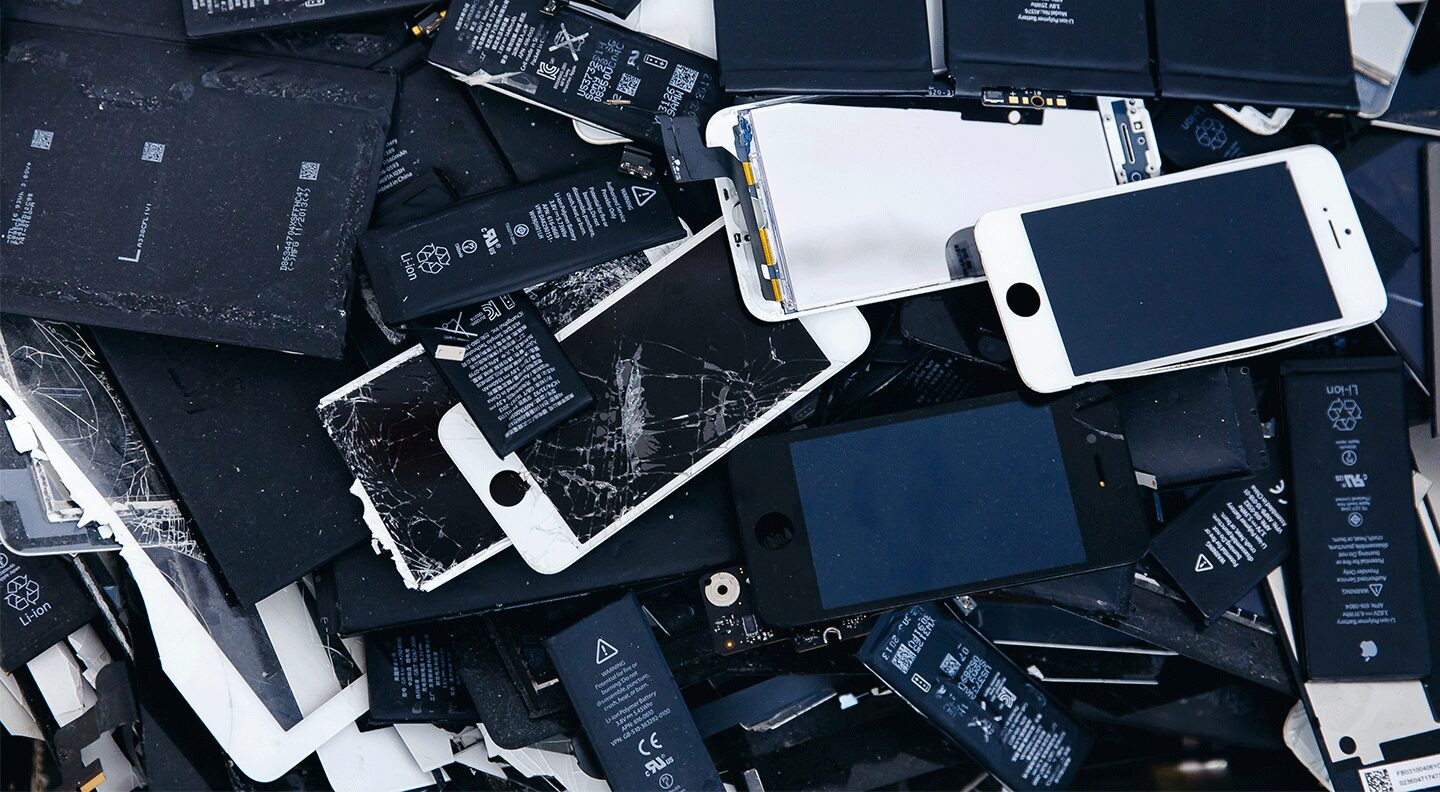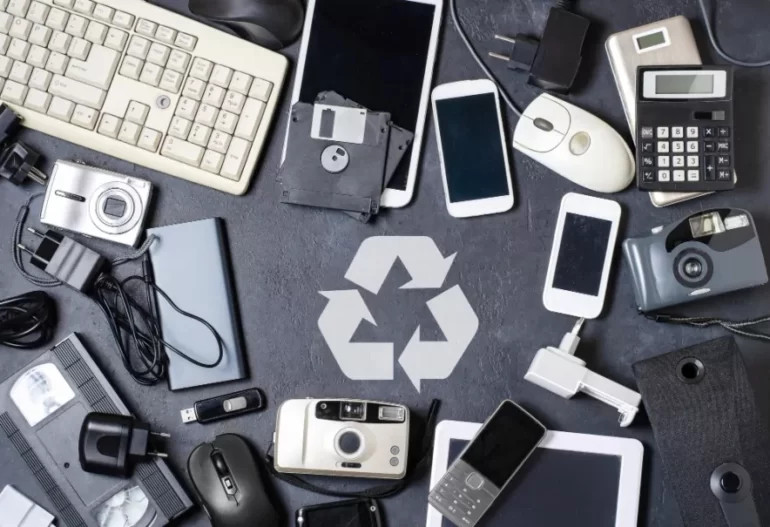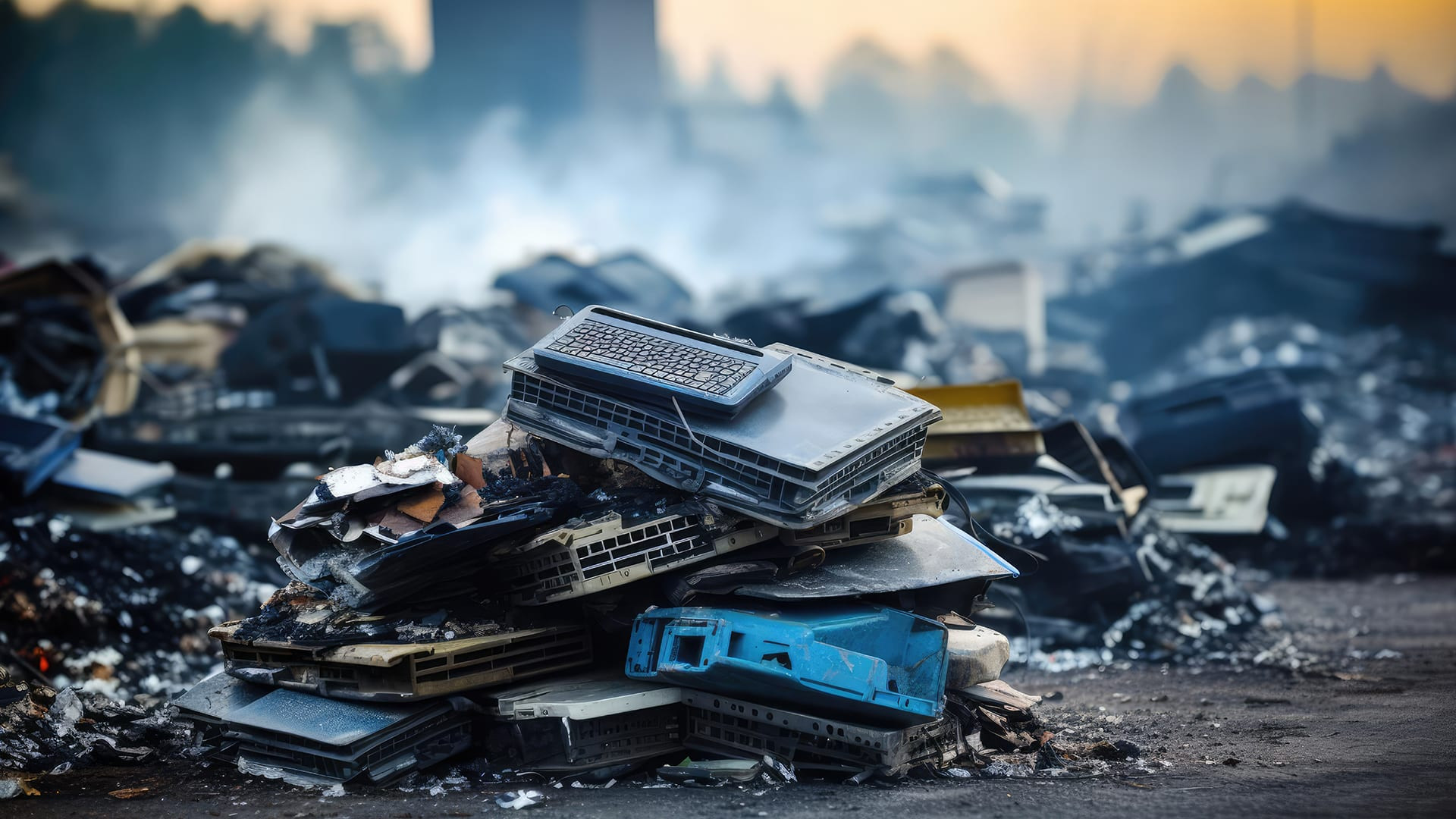Phones, batteries and electronics are thrown away five times more than they're recycled, according to a UN report.
Phone upgrades continue to offer less, and we're keeping our phones longer than we used to. But whenever we do eventually upgrade to the next big phone, we're throwing an awful lot of our old ones away, according to a UN Global E-waste Monitor report released earlier this year.
And we're even doing it at a rate that's almost five times faster than the equivalent materials are being recycled.
The volume of e-waste generated rose from 34 billion kilograms (about 75 billion pounds) to 62 billion kilograms (about 137 billion pounds) between 2010 and 2022, the UN report found. To drive the point home, the report estimates that this 62 billion kilograms of e-waste could fit on 1.55 million trucks, forming a line that would wrap all the way around the Earth's equator.
Meanwhile, the amount of e-waste that has been documented to be recycled has risen from 8 billion kilograms to just 13.8 billion kilograms in that same time period.
The UN's International Telecommunications Union set a goal to get 50% of the world's nations (97 countries) to adopt an e-waste policy, legislation or regulation by 2023. But the report shows that this effort is slowing down, and just 81 countries, or 42%, have done anything to address e-waste. There are factors that can interfere with accurate data. Systems for documenting and reporting the recycling of electronics vary widely by country, for one.
Here's what you can do to help deal with your old electronics.
There's no need to throw away your old phones, batteries, computers and other gadgets when there are many free and easy ways to recycle your electronics, including mailing, taking them to a recycling center, a big-box retail store like Best Buy or Home Depot or sometimes even the product manufacturer.
If you live near an Apple store, for example, you can hand in your old iPhone or other Apple products to be recycled, and some of those products may qualify for trade-in credit. According to the Apple Reuse and Recycling Program, turning in your devices can "help us get closer to making every product with only recyclable and renewable materials."
And here's where to recycle your old computers and printers for free.
For larger IT recycling needs, Dell's Asset Recovery Services will take and safely handle equipment even if it's actually not made by Dell. If your business or friend group has at least 10 phones to recycle, Smartphone Recycling accepts devices in bulk sent with the assistance of a free, print-at-home FedEx shipping label. In addition to phones, the company accepts Apple products and other tablets.
You could also repair your old devices, with iFixit offering DIY guides and tech companies now making it easier to remove and replace damaged parts. If you don't like the DIY route, you could also take it back to the manufacturer or a third party for a repair.
E-Waste Management: A CIO's Perspective
In this Q&A, Enrico Airaga, CTO at Desco Electronic Recyclers, offers insights into best practices for e-waste management, which is vital for reducing the environmental impact of electronics.
Environmental Regulations and Compliance
Q: What are the key environmental regulations and compliance requirements for CIOs?
A: The Basel Convention regulates the transboundary movement of hazardous waste, ensuring proper handling and disposal. One of the challenges is that the receiving party must prove they will recycle the e-waste and not dump it.
The waste electrical and electronic equipment (WEEE) directive is another key regulation, focusing on the collection, treatment, and recycling of e-waste in Europe.
In South Africa, CIOs must comply with the National Environmental Management Waste Act (NEMWA), which governs the disposal and recycling of e-waste, including hazardous materials like lead, mercury, and cadmium. It’s also essential to stay informed about regional regulations to ensure full compliance.
Key compliance areas include proper collection, treatment, recycling and reporting of e-waste, with a strong focus on minimising harmful environmental impacts.
Securely Wiping or Decommissioning Used PCs
Q: What are the best practices for securely wiping or decommissioning used PCs?
A: To mitigate data security risks, CIOs should use certified data wiping software, such as KillDisk or Blancco, which overwrites hard drives multiple times to ensure no recoverable data remains. If data wiping is insufficient, physical destruction of hard drives, using shredders or degaussers, ensures the data is irretrievable.
CIOs should also follow stringent decommissioning protocols, including asset tracking, authentication, and obtaining certificates of destruction from certified vendors. It’s important to remove all asset tags, labels, and identification marks from PCs before disposal.
Sustainable E-Waste Management Strategies
Q: How can CIOs implement sustainable e-waste management strategies?
A: Whenever possible, repair or refurbish old equipment for internal use or donate it to educational institutions or NGOs. CIOs should also consider shifting to leasing models, which allow for hardware upgrades and returns, minimising waste.
Component harvesting, which involves extracting useful parts from obsolete devices for reuse in other systems, is another option. Adopting a circular economy mindset by purchasing from vendors offering take-back programmes or designing products with recyclability in mind is also beneficial.
Evaluating Certified E-Waste Recyclers
Q: What criteria should CIOs use to evaluate and partner with certified e-waste recyclers?
A: CIOs should partner with recyclers that hold certifications such as ISO, which ensure adherence to environmental and data security standards. Recyclers should provide transparent reporting and full traceability of waste streams to ensure responsible processing of e-waste.
The recycler’s environmental impact is also critical. Evaluate their handling of hazardous materials and energy-efficient recycling methods. For international operations, ensure recyclers can manage cross-border movements of waste in compliance with international laws like the Basel Convention.
Aligning E-Waste Management with Sustainability Goals
Q: How can CIOs align e-waste management practices with broader corporate sustainability goals?
A: Incorporating circular economy principles is key. CIOs should aim to increase the percentage of IT assets that are refurbished, repurposed, or recycled. E-waste management should also be part of sustainability audits for suppliers and partners. Employee training is equally important and educating employees on sustainable IT practices can enhance overall corporate sustainability efforts.
Leveraging Emerging Technologies for Lifecycle Management
Q: What are your top tips for leveraging emerging technologies for lifecycle management?
A: AI can play a pivotal role in lifecycle management, particularly through automated sorting of e-waste components, which can significantly enhance recycling efficiency.
The Rise of Metal and Scrap Recycling
Metal and scrap recycling is an integral part of the modern industrial economy with implications that traverse both environmental sustainability and financial growth. It constitutes a significant segment of the materials industry—transforming waste into assets and breathing new life into used resources. By balancing ecological mindfulness and economic pragmatism, recycling creates a circular economy that benefits society at large. Whether in the manufacturing of new products or the conservation of natural resources, the role of this industry cannot be overstated. Keep reading to uncover the multifaceted advantages of metal and scrap recycling.
Economic Benefits of Metal Recycling
The recycling of metals and scraps is not merely a trend; it’s a booming industry that contributes substantially to economic development. The process of reclaiming and processing metals for reuse provides raw materials at a lesser cost than virgin ore extraction, allowing manufacturers to reduce expenses and enhance profitability. As such, recycling is a pivotal force in driving down the cost of production across multiple sectors.
Innovation and Technological Advancements
Apart from cost advantages, the industry spurs innovation by necessitating efficient material processing technologies. Companies invest in cutting-edge machinery to handle the intricacies of sorting and refining recycled metals, fostering a technology-focused growth sector. This, in turn, culminates in a competitive marketplace that speeds up both technological advancement and industry expansion.
Wealth Redistribution and Economic Growth
Recycling also encourages the redistribution of wealth by converting discarded materials into valuable commodities. This activity has a multiplier effect on the economy, catapulting the growth of ancillary businesses, such as transportation, equipment manufacturing, and trade. Nowhere is this circular economic approach more evident than in the realm of metal and scrap recycling.
Energy Savings and Environmental Impact
The energy savings associated with metal recycling are staggering. Manufacturing products from recycled metal uses significantly less energy compared to production with virgin resources. For instance, producing aluminum from scrap requires 95% less energy, which underscores the importance of recovering and reprocessing these materials.
Corresponding to energy reduction, the scrap industry plays an instrumental role in decreasing greenhouse gas emissions. By lessening our reliance on energy-intensive mining and processing practices, the carbon footprint associated with production is dramatically lowered, contributing to cleaner air and a healthier environment.
This eco-friendlier approach also aligns with global efforts to combat climate change. As governments and organizations worldwide advocate for emission reductions, metal recycling stands as a pragmatic solution that yields immediate and measurable results. It is a practical strategy that contributes toward the goals set by international climate agreements.
Job Creation and Workforce Development
The scrap recycling sector is a substantial job creator, offering employment across a diverse range of skill sets. From labor-intensive collection and sorting positions to high-tech jobs in refining and logistics, the industry’s employment spectrum is wide-reaching. As an essential element of the green economy, these jobs are crucial for the continued growth of a sustainable workforce.
In regions where job creation is a top priority, the metal recycling industry can act as an economic stimulus. The warmth of new employment opportunities gives life to local economies, stimulating growth and providing a strong foundation for community development. It’s the intersection of proactive socio-economic policymaking and environmental stewardship.
Moreover, jobs within the recycling sector often provide sustainable and long-term employment. As global demand for environmentally responsible practices increases, so too does the necessity for skilled workers in this field. It is an area replete with opportunities for career advancement and innovation.
Technological Advancements and Sustainability
The continuous improvement of metal recycling techniques is critical for advancing sustainable development. By enhancing efficiency and finding new ways to reclaim more materials, the recycling industry supports sustainable consumption and production patterns. These advancements also catalyze further research into environmentally friendly technologies.
Improved metal recycling techniques also mean expanded capacity for processing more challenging types of waste. As electronic waste becomes increasingly prevalent, the industry’s role in managing these complex materials is imperative. Developing sophisticated recycling methods helps divert toxic elements from landfills and recovers valuable materials for new uses.
The Future of Recycling: Innovation and Sustainability
Electronic waste and its associated pollution are becoming increasingly threatening on a global scale. With the continued development of various new application areas including robots, wearable devices, health monitors, and single-use devices, the production of new flexible electronic products is relentless, exacerbating related issues.
Moreover, although the impact of the COVID-19 pandemic on component supply chains such as chips has slowly faded, the fragility of global supply chains is now undeniable. Consequently, more electronic manufacturers are viewing the secondhand recycled components market as a safety net outside of regular supply chains.
In a promising development, engineers from the Massachusetts Institute of Technology (MIT) have partnered with teams from technology giant Meta and the University of Utah to develop a new flexible substrate material. This innovation can be used to produce electronic products with a longer service life. It also boasts advantages such as biodegradability and low manufacturing costs. The material could possibly improve the recyclability of various single-use and wearable device components.
vPCB: The Recyclable PCB
The issue of disposing of substrates and circuit boards is attracting more attention. Both the academic and business worlds are investing in research with the hope of solving this dilemma. In addition to MIT, a research team from the University of Washington (UW) has made a PCB from a material called vitrimer and named it "vPCB."
Traditional PCBs are fireproof and resistant to chemical corrosion, making them rather durable, and thus, hard to recycle and reuse. However, vitrimer possesses characteristics that allow for reprocessing, chemical recycling, and repairing of scratches, garnering attention for its potential to become a new sustainable material. Not only can this material be solidified to produce PCB, but after expanding it, its components can be retrieved for recycling and reusing.
The vPCB manufacturing process is very similar to that of traditional PCBs, which benefits its promotion to manufacturers. Furthermore, not only can vPCBs be recycled multiple times, but the amount of material wasted during the recycling process is also very low. According to estimates by the research team, within one piece of vPCB, up to 98% of vitrimer material and 100% of fiber-reinforced plastic can be recycled.
Turning E-Waste into Valuable Resources: Community Initiatives
Do you have questions about e-waste? There’s a free event coming up on Saturday, October 5, from 9 a.m. – 3 p.m. at the Mountain Iron Community Center that will help. Do you have a box full of end-of-life electronics that you need to get rid of? We’ll be accepting that for recycling!
The Iron Range Partnership for Sustainability (IRPS) in conjunction with the Department of Iron Range Resources and Rehabilitation, St. Louis County Environmental Services, Recycling Electronics for Climate Action (RECA), and Global Ewaste Solutions is hosting this event.
The state of Minnesota will again consider a 100 percent e-waste collection bill this coming spring and it looks like it will pass. That will be a huge change in our state, from collecting/recycling only 20 percent of our e-waste to now gearing up to deal with all of it. Not only is e-waste full of valuable critical metals now being lost to landfills, but it is also toxic when landfilled.
E-waste in a dump leaches mercury, the most toxic heavy metal in the environment, and cadmium and chromium, two strong carcinogens. It leaches lead which causes nervous system damage and interferes with reproduction, and it leaches flame retardants. And if that isn’t enough reason to recycle them responsibly, e-waste batteries cause landfill fires.
On the upside, the Iron Range Partnership for Sustainability, in conjunction with Macalester College and RECA, published a study identifying 68 critical metals needed for the energy transition that are plentiful in e-waste. In fact, these metals are far more concentrated in e-waste, pound-forpound, than in raw ore from the earth.
Minnesota generates about 267 million pounds of e-waste each year containing $3.2 billion worth of recyclable metals. You can help turn the corner on e-waste by bringing your e-waste to the October 5 event and attending the educational sessions offered inside the community center that day.
In addition to educational displays, tables, videos, and live speakers, IRPS will sell fresh-baked cocktail pasties from Paul’s Italian Market and Buns to Go food truck will offer their porketta specialties in the parking lot during the event. We’ll have pumpkin decorating for the kids all day, and two half-hour story sessions by author, Adam Byrn Tritt. So bring the family, leave your e-waste, and bring a pumpkin home!
A Symbiotic Relationship: Metal and Scrap Recycling's Future
Altogether, metal and scrap recycling is a poignant example of how the economy and environment can coalesce to form symbiotic benefits. Overall, the industry not only safeguards our planet by conserving resources and reducing pollution but also provides the foundation for economic resilience and green growth, shaping a promising future for generations to come.



















